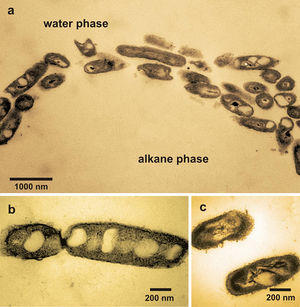Oil spillsOil-devouring microbe communities a mile deep in the Gulf
The Deepwater Horizon explosion on 20 April 2010, caused the largest marine oil spill in history, with several million barrels of crude oil released into the Gulf of Mexico over the course of three months. Soon after the spill began, a massive oil slick was visible from orbiting satellites, yet once the underwater gusher was sealed, obvious traces of the crude oil disappeared much sooner than nearly all observers predicted. Some of the oil evaporated; some was skimmed off. Microbes “ate” much of the oil as well.

Photomicrograph of one species of oil-eating bacteria // Source: niaolei.org.cn
The Deepwater Horizon explosion on 20 April 2010, caused the largest marine oil spill in history, with several million barrels of crude oil released into the Gulf of Mexico over the course of three months. Soon after the spill began, a massive oil slick was visible from orbiting satellites, yet once the underwater gusher was sealed, obvious traces of the crude oil disappeared much sooner than nearly all observers predicted.
Some of the oil evaporated; some was skimmed off. Microbes “ate” much of the oil as well — the ocean hosts a variety of microscopic animals that feed on the hydrocarbons that make up crude oil, digest them, and eventually release their remnants as carbon dioxide. These aerobic microbes use oxygen dissolved in the sea to oxidize hydrocarbons to carbon dioxide.
In the deep-sea environment of the seabed, though, oxygen is a rarer commodity, so anaerobic microbes might have to shoulder the lion’s share of any crude oil cleanup. And the sea floor is where some of the crude oil certainly settled — just how much, though, and its fate, is the subject of differing viewpoints in the scientific community.
A University of South Carolina release reports that Pamela Morris of the University of South Carolina helped lead a team of scientists that recently released a study shedding light on those questions. The team’s metagenomic analysis of the deep-sea subsurface sediments was published in Frontiers of Microbiology.
In mid-September 2010, two months after the gusher was sealed, a Lawrence Berkeley National Laboratory team led by Terry Hazen began collecting deep-sea sediment cores in the area surrounding the epicenter of the spill. The samples were shipped to Morris’ laboratory at USC’s Belle W. Baruch Institute in Georgetown, South Carolina, where she oversaw an analysis of the community genome in the deep-sea subsurface.
Using a pyrosequencing platform, the team quantified genes from three sample sites — two were less than three km from the Deepwater Horizon rig, and one was 128 km from it — and classified the microbes phylogenetically.
Owing to the extreme depth (1,500 meters) of the waters in the area, the data were a substantial addition to the dearth of existing data points. “In the Gulf of Mexico, the only metagenomes that were available to compare to were the Brazos-Trinity and Peru Margin,” said Morris, referring to samples obtained from off the coast of Texas and Peru, respectively.
In the sample areas closest to the spill site, the Deltaproteobacteria class was more abundant within the microbial community. Moreover, an early analysis of probable anaerobic hydrocarbon metabolites (alkylsuccinates) lent credence to the conclusion that anaerobic bacterial species in this class were responding to the presence of hydrocarbons on the seafloor.
“We weren’t able to analyze as many samples as we would have liked,” Morris said. “But in these deep-sea subsurface sediments, it does look like the microbial communities are becoming enriched in species that are capable of anaerobic oil degradation near the spill area. The metagenomic analysis we did suggests that there’s a shift toward organisms with the capability to anaerobically degrade oil, and the preliminary metabolomic data validated that. We hope to explore this further.”
Given the amount of oil that was released, Morris thinks developing a better understanding of the microbe community on the sea floor is crucial.
“Some of the oil most likely settled in some of these deep regions in the Gulf of Mexico. There’s no idea of how much of it did – there are differing views in the scientific community,” Morris said. “We need to get a better feel for what’s going on in these deep-sea sediments that are contaminated.”
— Read more in Nikole E. Kimes et al., “Metagenomic analysis and metabolite profiling of deep–sea sediments from the Gulf of Mexico following the Deepwater Horizon oil spill,” Frontiers of Microbiology 4, no. 50 (21 February 2013) (doi: 10.3389/fmicb.2013.00050)
